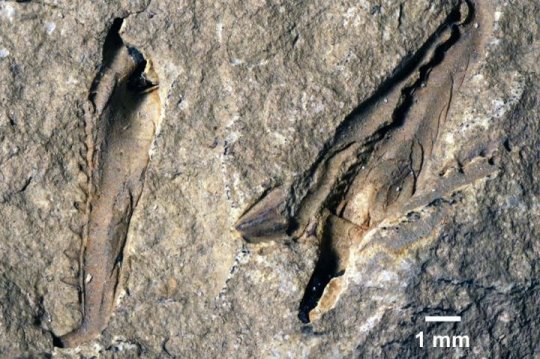A previously undiscovered species of an extinct primordial giant worm with terrifying snapping jaws has been identified by an international team of scientists according to Science daily.
Researchers studied an ancient fossil, which has been stored at the museum since the mid-1990s, and discovered the remains of a giant extinct bristle worm (the marine relatives of earthworms and leeches).
The new species is unique among fossil worms and possessed the largest jaws ever recorded in this type of creature, reaching over one centimetre in length and easily visible to the naked eye. Typically, such fossil jaws are only a few millimetres in size and need to be studied using microscopes.
Despite being only knows from the jaws, comparison with living species suggests that this animal achieved a body length in excess of a metre.
This is comparable to that of ‘giant eunicid’ species, colloquially referred to as ‘Bobbit worms’ which are fearsome and opportunistic ambush predators, using their powerful jaws to capture prey such as fish and cephalopods (squids and octopuses) and dragging them into their burrows.
Lead author Mats Eriksson said: “Gigantism in animals is an alluring and ecologically important trait, usually associated with advantages and competitive dominance.
“It is, however, a poorly understood phenomenon among marine worms and has never before been demonstrated in a fossil species.
“The new species demonstrates a unique case of polychaete gigantism in the Palaeozoic, some 400 million years ago.”
Co-author Luke Parry from, added: “It also shows that gigantism in jaw-bearing polychaetes was restricted to one particular evolutionary clade within the Eunicida and has evolved many times in different species.”
The specimens were collected over the course of a few hours in a single day in June 1994, when Derek K Armstrong investigated the rocks and fossils at a remote and temporary exposure.
Sample materials, from what proved to belong to the Devonian Kwataboahegan Formation, were brought back, where they have been stored until they caught the eyes of the authors’.
avid Rudkin said: “This is an excellent example of the importance of looking in remote and unexplored areas for finding new exciting things.”
Luke Parry added: “This is fitting also since, beside our appetite for evolution and paleontology, all three authors have a profound interest in music and are keen hobby musicians.
N.H.Kh

